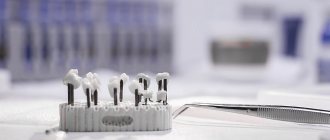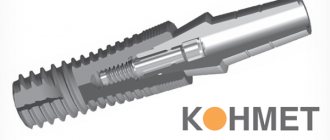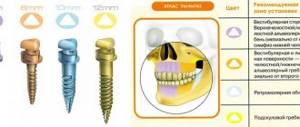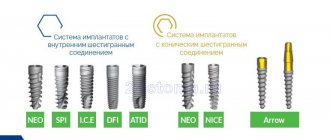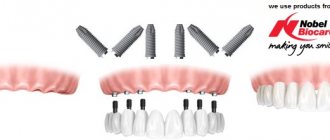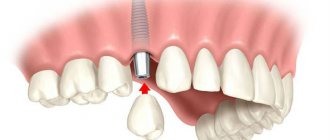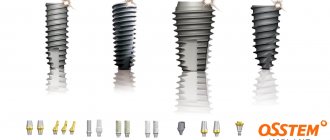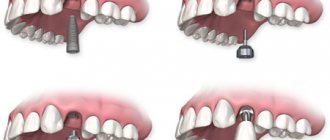Family planning and the issue of protection against unwanted pregnancy have become a huge industry over the past 40 years. The number of drugs that have been developed to control the cycle and prevent pregnancy is simply enormous. These remedies are taken by millions of women around the world, and scientists are constantly developing new products. The latest invention is the Implanon subcutaneous implant, which protects you from the possibility of conceiving for 3 years at once. Although the procedure is quick and minimally invasive, only a certified gynecologist can perform it to prevent complications.
Implanon is a new modern method of long-term reversible contraception. Installation of a subcutaneous implant containing progestogen allows you to forget about other methods of contraception for as long as 3 years and not worry about an unwanted pregnancy.
Has financial benefits over other means of contraception.
The implant is a small flexible rod 4 cm in length and only 2 mm in diameter. The gynecologist installs it under the skin on the inside of the forearm through a small puncture using a special applicator. The procedure is performed under local anesthesia. After installation, the implant is completely invisible; it can only be felt when pressing on the insertion site.
"Implanon" is a long-acting hormonal contraceptive; it reliably suppresses ovulation; according to clinical studies, the effectiveness of "Implanon" is 99.9%. When using Implanon, as well as other contraceptives containing progestogen, the nature of menstrual flow may change. The contraceptive "Implanon" has a reversible effect; after removal of the implant, hormonal levels are restored within 100 hours, ovulation is restored within 3 months. A woman can consult a gynecologist to have Implanon removed at any time she wishes.
What is dental implantation?
Implant installation is a surgical procedure that involves fixing a pin into the alveolar ridge that follows the shape and characteristics of the natural root. After adaptation, prosthetics are performed. Advances in medicine make it possible to restore the attractiveness of a smile.
A cone-shaped screw is made of titanium. The material is distinguished by its quality, strength, long service life, and high survival rate. Does not provoke allergies, in 99% of cases it is integrated into the body without adverse reactions. An abutment (a cone resembling a ground tooth) is attached to the pin to securely fix the crown.
To restore the upper and lower jaw simultaneously, osteoplasty is prescribed to ensure reliable fastening of the implant screw in the alveolar ridge.
Why is implantation needed?
What kind of shell is there?
In all old-generation implants, the shell was smooth. Starting in the late 80s, a transition to textured (i.e., rough) casings began, and today the majority of products (about 90%) have this casing option. The shell of new implants is similar in structure to a sponge, so it is much easier for the soft tissues of the breast to grow into the “rough” surface. In this regard, a modern implant is more readily “accepted” by your body, is better fixed inside the breast and does not cause fibrosis, that is, hardening of soft tissues, unlike smooth implants, which were dangerous in the first place.
Also, modern shells are often multi-layered in order to reduce the risk of external damage.
Scheme of the surface of a smooth and textured implant:
Types of implantation
The following types of implantation are distinguished:
One-stage dental implantation
The surgical intervention involves the implantation of an artificial root, which is installed with a crown within three days. It secures the position of the roots, and chewing pressure stimulates blood flow and regeneration of the solid organ.
An impression should be made in advance to be recreated in a dental laboratory. With express implantation, the rod is fixed into the deep parts of the jaw, which eliminates augmentation.
It is carried out in one stage after careful preparation of the oral cavity. The pin is screwed in under local anesthesia. An incision is made in the gum and no stitches are required. The minimally invasive nature of the intervention shortens the rehabilitation period.
Advantages of one-step implant installation:
- finished result in three days;
- non-invasive;
- no need for sinus lift;
- aesthetics;
- durability;
- saving time and money.
One-stage dental implantation
It involves installing an implant immediately after tooth extraction in one visit. After which the doctor places a temporary crown, and after 40-60 days a permanent crown is placed on the implant.
In practice, it is used quite often, but this type of implantation requires a sufficient amount of bone tissue. It is expensive. The risk of rejection of the installed implant is negligible. Preserves the gum contour and eliminates the need for augmentation. Allows you to achieve maximum attractiveness.
Disadvantage: requirements for the health of the oral cavity at the time of dental implantation; the absence of catarrhal phenomena and general problems at the time of surgical procedures is necessary.
Two-stage dental implantation
Classic two-stage implantation provides for late orthopedics - crowns are placed 3-6 months after installation of the implants. Provided in 2 stages.
At the first stage, the doctor makes an incision in the gum, exposing the bone, in which he makes a hole with a pinhole punch. The implant is placed in the finished hole. The gums are sutured. The period of fusion of the implant with soft tissues takes from 3 to 6 months. During this time, temporary plastic crowns are installed. They perform aesthetic activities in full, and chewing partially - you can only eat soft, crushed food.
At the second stage, the specialist removes the plug from the implanted implant, installs the former, thereby preparing the gums for orthopedic work.
The overlay improves the fixation of the permanent structure, giving maximum authenticity. After successful formation of the notch, the contour is removed. An abutment is attached to the implant and a permanent crown is placed.
Specifics of two-stage implant installation:
- the need for preliminary diagnosis;
- preparation of the oral cavity, relief of local diseases;
- the need for bone grafting;
- caution in eating until the end of osteoregeneration.
Mini implantation
In our dentistry you can use the mini-implantation service. It involves the use of implants reduced in size to 1.8 mm.
The installation of a mini-implant is used when there is insufficient bone tissue, to avoid tissue injury. It differs in that the patient will not spend a lot of money on this procedure. Involves immediate loading of the crown. The duration of the procedure varies from 30 to 90 minutes.
Disadvantage - insignificant durability - excessive chewing pressure is dangerous for destruction, so insert dentures are mounted on mini-pins.
Combined installation of implants
Combined transplantation combines several techniques to achieve optimal results. The main indication is the restoration of units in different rows and sections of the same row, edentia. An individual method, selected based on the client’s health status, limitations, financial condition and wishes.
Combination variations:
- Restoration of the smile area using express techniques. Molars are restored using a classic or basal technique, since they bear the greatest chewing load;
- A combination of different dimensions, based on the volume of the bone;
- A combination of removable and non-removable structures fixed to various implants.
The positive nature of the combination:
- maximum aesthetics and functionality;
- combining the capabilities of each method;
- avoids augmentation;
- reduces the cost of work.
What are bioimplants and why are they good?
So-called bioimplants have become a completely new word in implantation technology. The silicone that filled the previous generation of implants was replaced with hydrogel, and this gave amazing results:
- a biological implant completely eliminates the risk of fibrosis;
- with bioimplantation you will not feel the “cold breast” effect;
- bioimplants do not require a large incision for installation. A small cut on the areola is quite enough;
- the hydrogel is non-toxic and will not harm you;
- installation of bioimplants is “lifelong” - they do not have to be replaced after a few years like silicone ones.
The only manufacturer of bioimplants is the French company Arion. These implants have no analogues in terms of safety and reliability, and in 2011 they were awarded the title of the most modern product for thoracic endoprosthetics.
Specialists from the Clinic of the GENESIS Medical Academy perform all types of operations with bioimplants, using the most modern advances in the field of mammoplasty. Bioimplants meet the most stringent health safety criteria, therefore, by choosing bioimplantation at the Clinic of the GENESIS Medical Academy, you can be sure of one hundred percent effectiveness.
Stages of installing dental implants
Regardless of the method used, any dental implantation is always carried out in several stages: preparatory, surgical, orthopedic and rehabilitation. The only difference is the duration of each period.
Preparatory stage
At the preparatory stage, in order to identify contraindications, the patient is consulted by several dental specialists: a therapist, an implant surgeon and an orthopedist. If there are no contraindications to implantation, the patient undergoes a full examination, including the following points:
- complete sanitation of the oral cavity, including replacement of old fillings;
- removal of movable units and damaged teeth that cannot be restored;
- treatment and prevention of periodontal pathologies (if necessary);
- professional hygienic cleaning with thorough removal of supragingival and subgingival dental plaque;
- consultation with an orthopedic dentist, if the patient has previously installed orthopedic structures, if necessary, their cleaning and repair;
- radiography - panoramic image (OPTG);
- cone beam computed tomography (CBCT);
- patient training in specific care of implants.
Since the installation of implants is a full-fledged surgical operation, the patient must undergo laboratory diagnostics. He gives:
- general clinical blood test;
- blood chemistry;
- coagulogram;
- blood group and Rh factor;
- blood test for syphilis (RW), HIV infection, hepatitis B and C (HBV and HCV).
If there are any chronic somatic pathologies, the patient is referred for consultation to a therapist and specialists of the relevant profile - an allergist, endocrinologist, cardiologist, neurologist or ENT doctor (especially if surgery on the upper jaw is planned).
Based on the results of the examination, the implant surgeon draws up a general plan for dental implantation. He evaluates the density and structure of bone tissue, the width of the alveolar process, and pays attention to the condition of the mucosa. In case of severe bone atrophy, as part of the preparatory stage, operations to build it up (bone grafting) are performed. In this case, the engraftment process can take from 3 months to a year.
Surgical stage
At this stage, an artificial root is installed. The procedure begins with anesthesia. The choice of method depends on the area where the implant will be installed, the installation method and the extent of the operation. Most often, application anesthesia is performed first, and then infiltration anesthesia.
After the anesthetic has taken effect, the implant surgeon provides access to the bone by cutting the gum and periosteum and then peeling away the tissue.
Then he begins to form the bone bed. The process involves gradually expanding the hole. Its size must exactly match the length and diameter of the selected implant.
To create a bed, special cutters of various diameters are used, and abundant irrigation with saline is required, which prevents heating of the bone and helps push the chips out of the hole. The process is controlled using taps.
As soon as the bed is prepared, the implant is screwed in and closed with a special plug screw. It prevents the penetration of pathogenic microorganisms and prevents direct contact with mechanical irritants, which contributes to better implant healing. At the final stage of the operation, the surgeon puts the periosteum and soft tissue back, after which he applies sutures. Osseointegration after implant installation takes about 2-3 months for the lower jaw and 4-6 months for the upper jaw.
Stage of gum formation
The next stage is the installation of the gum former. It is a titanium cylinder that is screwed into the implant cavity. Its role is to create a clear and even contour of the gums, indistinguishable from the edge surrounding the “native” teeth. The element is fixed 3-6 months after osseointegration is completed. To do this, the doctor cuts the gum, removes the plug, and installs a gum former in its place. The period of soft tissue regeneration and the formation of the gum ridge takes about two weeks.
Abutment installation stage
An abutment is an adapter that connects the implant and the crown. It is installed in place of the gum former after two weeks, when the soft tissues have completely healed. The size and shape of the abutment are selected taking into account the characteristics of the orthopedic design and thus allow the crown to be accurately “fitted” into the dentition.
Prosthetics stage
Prosthetics begins immediately two weeks after the permanent abutment is installed. A crown can be installed on the implant (in case of single defects), or it can serve as a support for removable and fixed dentures.
The prosthetics stage begins with taking impressions of the jaws, on the basis of which an orthopedic structure will then be made. This process takes about 2-3 weeks.
After several corrections and several fittings, the prosthesis is finally installed.
A single crown is fixed using special adhesive materials, and volumetric dentures are installed on a beam structure or secured using a spherical support.
Postoperative period
After the anesthetic wears off, the patient may experience discomfort. Their intensity and duration are purely individual indicators. The discomfort goes away after about 4-5 days. During this period, the doctor may prescribe painkillers. If the symptoms do not disappear, but on the contrary, increase, it is necessary to urgently contact the dentist who performed the implantation.
In addition, a number of restrictions apply in the postoperative period. In particular, flying, visiting saunas and taking hot baths are prohibited. You should not sleep on the side where the implant is installed, and you should definitely avoid any physical activity. Compliance with these rules will prevent excessive blood flow to the operated area and the appearance of edema, and with them the inflammatory process. Otherwise, peri-implantitis may develop.
In the postoperative period, it is recommended to brush your teeth with a brush with soft bristles, rinse your mouth very carefully, and even better, take baths with an antiseptic.
Rehabilitation stage
After implantation, all patients are required to undergo regular dental monitoring. This is necessary to prevent complications, as well as to carry out professional hygiene of teeth and orthopedic construction, which is carried out at least once every six months.
In addition, all patients must adhere to certain rules:
- regular and thorough oral hygiene;
- using only high-quality care products;
- refusal of rough and hard food;
- mandatory rinsing of the mouth after each meal with solutions with antiseptic properties.
In addition, a person who has undergone implantation must constantly listen to his own feelings and, if the slightest discomfort occurs, immediately consult a doctor.
The use of silicone implants in plastic surgery
The scope of use of silicone implants is very wide. They can be used for the following purposes.
- Reconstruction of the mammary glands after mastectomy. Due to cancer, the mammary glands may be partially or completely removed. Installation of endoprostheses can be carried out simultaneously with the removal of a cancerous tumor or some time after removal of the glands
- Mastopexy (breast lift). Implants are used if the patient wants to change the volume in addition to the shape
- Endoscopic breast augmentation. This method is used in cases where the incision is made in the area under the armpit, since it is possible to form a pocket for placing the implant using optical instruments. The surgeon needs an endoscope for visual control during the operation.
- Gluteoplasty is a change in the volume and shape of the gluteal area. Special implants are used that can withstand heavy loads - sitting, running, physical exercise. Such endoprostheses have a durable shell and silicone filler.
- Kuroplasty - correction of the shape of the calves. Implants make it possible to correct crooked legs and add additional volume if the muscle layer is too thin or hypotrophied
- Rejuvenating change in facial features. To correct facial proportions, endoprostheses of various sizes and shapes are used. Using them, you can emphasize your cheekbones, add volume to your chin or jaw, and smooth out the areas under your eyes. Special prostheses made of hard silicone are used for the face. Often implants with a thickness of 4 mm are installed, for a pronounced result - 5-6 mm. In addition, endoprostheses can be made in individual sizes.
What implants do we use?
A high-quality pin is the key to success. In our work, we use only high-quality, improved mechanisms that have proven themselves in the world market. And the use of advanced technologies eliminates complications and guarantees the entire period of operation. At Cerekon, the operation is carried out using the following systems:
Straumann implants
A medical product from the Swiss organization Straumann, implants have been known since 1974.
Positive properties of Strauman implants:
- union of titanium alloy with zirconium;
- no intolerance;
- can be transplanted in case of autoimmune pathologies, heavy smoking;
- accelerated process of osseointegration;
- excellent quality;
- minimum number of restrictions;
- many abutments;
- variety of designs;
- lifetime warranty from the manufacturer.
Astra Tech implants
Astra Tech dental implants from the Swedish Astra Association can be implanted when other systems are not suitable.
Astra Tech implants have many advantages:
- impeccable quality is ensured by the inclusion of titanium of the maximum degree of processing;
- osseointegration after implant installation - within 12 weeks in 99% of clients;
- the risk of injury is reduced to zero;
- screwed in at different bone densities of the alveolar ridge;
- the likelihood of catarrhal processes is minimized;
- fast accommodation;
- installation is possible with immediate or remote prosthetics;
- lifetime warranty.
Cortex implants
This is an Israeli system, represented by Cortex implants for a classic, instant and one-stage operation, updating the front area. The company also offers a Premium Set, which includes not only the artificial root, but also the pontic, caps, and screws.
Individuality of Cortex implants:
- immediate stabilization in the bone;
- high quality materials;
- biocompatibility;
- hypoallergenic;
- the presence of a serial mark warning of counterfeit;
- 15 year warranty;
- installation variability;
- possibility of non-invasive installation;
- no discomfort after fusion.
The disadvantage is the low porosity of the rod process, which increases the duration of osseointegration.
Xive implants
German XiVE implants, which are positioned as VIP dentistry. German production offers designs from 3 to 5.5 mm, lengths from 8 to 18 mm.
They have such advantages as:
- ideal for implantation into narrow interdental spaces;
- used for complete edentia;
- fixed in case of bone tissue deficiency;
- suitable for basal and immediate implantation;
- individual abutments;
- lifelong operation;
- distinctive characteristics of the thread: in the apical part for cutting bone tissue, in the center and at the base it is smaller, which is necessary for condensation;
- no contraindications;
- porosity of the edges, which ensures engraftment in a minimum period for 99.3% of clients;
- the hexagonal connection guarantees the absence of inflammation;
- minimum duration of rehabilitation after surgical procedures.
Dentium implants
Dentium implant systems from the Korean manufacturer have been known for their technological excellence, safety and ease of installation since 2007.
Dentium implants have the following properties:
- long period of wear;
- harmlessness of materials;
- fast (within 2-4 months) and high-quality engraftment;
- a special model of the root process eliminates discomfort and evenly distributes pressure on the jaw;
- Can be used for immediate prosthetics;
- low-traumatic orthopedic work;
- acceptable price;
- double thread makes installation easier and faster;
- compatibility with all orthopedic elements;
- the ruler is represented by screws of different lengths and diameters;
- can be used in the smile area.
SuperLine implants
SuperLine implants are a system from the above-mentioned company Dentium, South Korea, which produces materials, tools, and equipment.
Has the following qualities:
- easy to fix;
- implanted in one visit to the doctor;
- the implant is as similar as possible to ordinary roots - it evenly distributes chewing pressure on the jaw;
- many models for each clinical case;
- long lasting performance
Method of installing dental implants
The above stages of pin installation are typical for intramaxillary structures, however, other implantation methods are also used in dentistry. These include the non-surgical method of tooth replacement and the installation of dental implants in a transgingival manner.
Express installation of dental implants
Implantation using the express method is performed immediately after the removal of a diseased tooth. The procedure for preparing the bed, implanting the pin and installing the crown is carried out in one visit. The technique is considered non-surgical, since the doctor works with a ready-made hole formed at the site of tooth extraction. During dental procedures, there is no need to cut the gum, so surgical intervention is kept to a minimum.
Transgingival implantation
Transgingival implantation refers to a special technology for installing a dental implant, which allows a pin to be inserted in one step.
What it is
The essence of the method is to perform a so-called puncture of the mucous membrane, carried out using a mucotome instrument. With its help, the doctor makes a circular incision in the gum, which is equal in size to the gum former. This method attracts patients with its low trauma and faster gum healing.
Stages
The transgingival implantation process includes the following steps:
- mouth disinfection and anesthesia;
- puncture of the mucous membrane;
- expansion and deepening of the hole according to the required dimensions;
- installation of an appropriate implant;
- placement of the healing abutment.
Indications and contraindications for implant installation
Dental surgery is indicated in the absence of teeth, when restoration by other methods is impossible or contraindicated.
For edentulous patients, installing implants is the most appropriate solution, since removable structures are not securely fixed in the oral cavity. Non-removable parts are firmly attached to titanium cones.
In case of incomplete edentia, the installation of implants allows you to preserve the integrity of the adjacent teeth, which are ground down to fix the adhesive bridge. The technique prevents the consequences associated with the destruction of enamel.
Despite the many privileges, there are contraindications.
Absolute contraindications to implant installation:
- pathologies of hematopoiesis, gemma coagulation;
- oncology;
- autoaggressive diseases (diffuse changes in fibrous tissue, rheumatoid arthritis, pemphigus);
- severe diseases of the central and peripheral nervous system;
- therapy with bisphosphonic acid derivatives;
- tuberculosis;
- aphthous stomatitis;
- hypertonicity of the masticatory muscles;
- diabetes.
Relative restrictions on dental implantation:
- poor quality oral care;
- infectious and inflammatory pathologies of teeth and gums;
- smoking;
- bruxism (involuntary grinding of teeth);
- osteoporosis.
All relative contraindications prevent implantation until they are eliminated.
Nicotine addiction is a bad habit that increases the risk of complications after surgery, including pin rejection. The onset of unpleasant consequences can be reduced by using basal or two-stage implantation, which involves prosthetics after osseointegration.
What's inside?
Since 1994, cohesive gel has been used as a filler for implants. The technology, pioneered by McGhan Medical, was able to perfectly simulate breast tissue. The main advantage of the gel is that it has “shape memory,” that is, it “remembers” the shape that the shell gives it and returns to it after any deformation.
Implantation with complete edentia
Adentia is the complete absence of teeth. Implantation has its own personality. Previously, patients were offered insert dentures attached to the gingival arch. This caused a lot of inconvenience. Modern advances make it possible to eliminate discomfort due to the reliable fastening of permanent orthodontic structures to the abutment.
For edentulous patients, the following methods of installing implants are used:
- Basal (classical) – implantation of up to 14 rods in each jaw. After their successful adaptation, a separate fixation is put on each one. Sufficient bone mass is required or osteoplasty is performed. It is expensive. Prosthetics are carried out delayed, since the method is invasive. Titanium screws take a long time to adapt to. During this period, a removable prosthesis is attached, which gives an attractive smile and is suitable for eating soft, crushed food.
- All-on-4, its modifications All-on-3, All-on-6. An exceptional version of implantation with immediate loading. The prosthesis is attached to 4, 3 or 6 supports, respectively. During the operation, elongated structures are used, implanted into the deep layers of the alveolar process at an angle. The method is low-traumatic in comparison with the basal method. Does not require osteomalacia. Used after extraction.
- Mini-implantation – involves the use of up to 14 fixed rods, created according to individual parameters. A removable prosthesis is attached to them. The technique is minimally invasive and is used for bone degeneration.
Mini implantation
All-on-4 implantation
Basal implantation
Form
- Round. The advantage of such endoprostheses is that they do not change the shape of the breast when changing body position. The disadvantage of these implants is that they round the upper part of the bust, which looks unnatural
- Anatomical (teardrop-shaped). These implants look better visually, but when they are rotated, the bust looks unnatural. The surface texture of such endoprostheses is not smooth.
Location of the relatively large chest muscle
- Subfascial. They are placed between the tissues and the chest muscle, but below its fascia. Some aesthetic surgeons believe that this helps achieve a more secure fixation.
- Subglandular. Placed between the tissues of the glands and the pectoral muscle. This method provides the best visual result. But it is not indicated for patients with a large bust and thin soft tissue of the mammary glands.
- Subspectral. Implants are placed partly under the mammary gland and partly under the mammary gland muscle, dissected from below
The appropriate shape, volume and method of implant installation are selected together with the surgeon during the examination.
See more “Before” and “After” photos
Why you should choose implant installation at the Cerekon clinic
Dental implantation is a progressive method of restoring the aesthetics and capabilities of the dentition.
Installing implants has the following advantages:
- prevents dystrophy of the jaw bone by uniformly distributing pressure;
- there is no need to grind adjacent units, which preserves dental health;
- recreates naturalness;
- lifetime guarantee subject to compliance with the surgeon’s postoperative recommendations and oral hygiene;
- After osseointegration, you can eat any food.
At the Cerecon clinic you can get a free consultation on the choice of implantation method and the implants themselves that are supposed to be installed. When rehabilitating, a specialist takes into account the non-standard nature of the dentition, general health, and financial capabilities. We offer root-shaped devices of personal sizes and further prosthetics using various raw materials. In our work we use high-quality, certified consumables. This guarantees a lifelong result, eliminates complications, recreates the attractiveness of the smile and the functionality of the jaw.
See prices for implantation
What shape does the implant have?
Modern implants are divided into round and anatomical.
Until the last decade of the last century, implants were only round, however, as practice has shown, such endoprostheses are not always able to imitate the correct anatomy of the female breast, so at the turn of the 80-90s, researchers seriously thought about developing an anatomical shape for the implant. The anatomical model, which was shaped like a drop of water, was created in the early 90s. It is worth noting that today’s medical practice does not exclude the use of round implants, since their price is more affordable and sometimes they are quite sufficient to recreate the correct breast shape.
Surgeons at the Clinic of the GENESIS Medical Academy work with both options, and the question of which implant to use will only be decided together with you. The shape of the implant will be determined based on your aesthetic preferences, the shape of your breasts and the expected result.
Reviews
5/5 After the injury, my husband’s teeth began to break badly.
We contacted Cerekon to solve the problem. The doctor recommended not to delay implantation in order to avoid plastic surgery in the future. The husband underwent a week of antibacterial treatment. In one visit, my man’s teeth were pulled out and 6 implants with a permanent prosthesis were installed. I'm very happy with the result. The husband began to smile again. Thank you very much to the specialists. Olga, 45 years old
5/5 Due to my stupidity, I lost the “facade” of my teeth. Cerecon installed two implants and zirconium crowns using the express method. Fast, affordable. I'm happy with the result. Artificial kits cannot be distinguished from real ones, no unpleasant sensations. Thank you Vadim, 32
Sign up for a free consultation:
Sign up now +7(495) 105 92 30 Useful information
Composition or type of filler
One of the simplest selection criteria is the type of filler. The first to appear on the horizon of aesthetic medicine were saline implants filled with saline solution. The saline solution consists of water and salt (sodium chloride) at a concentration of 0.9%. From the point of view of biological compatibility and safety, salt prostheses are ideal, but the same cannot be said about their durability.
Saline endoprostheses
Saline implants are most susceptible to mechanical damage. They require replacement more often, and their service life is lower than that of more modern hydrogel or medical silicone implants. There is a risk of volume reduction due to the gradual penetration of saline solution through the capsule. This process does not threaten your health, but it does have a negative effect on the aesthetics of the breast. Another disadvantage is that saline implants are too soft, resulting in breast augmentation that does not feel natural enough to the touch.
Nevertheless, prostheses filled with saline also have their strengths. They are filled after the shell is installed in the anatomical pocket, which allows the operation to install breast implants through very short incisions. For the same reason, it is easier to control the symmetry of the bust during surgery, which is especially important for women with initially asymmetrical breasts. In some cases, the volume of the endoprosthesis can be adjusted even after surgery, which is also a plus.
Silicone implants
Silicone implants are installed through relatively long incisions, which results in more visible scars on the skin after surgery. This is their main drawback. Otherwise, silicone endoprostheses have many advantages, which explains the high popularity of this type of filler both among plastic surgeons and among their patients:
- Medical silicone is completely biologically compatible with the tissues of the human body. It is safe and does not provoke an immune response or inflammatory reactions.
- Modern implants are filled with a dense gel with shape memory, which does not penetrate beyond the shell even after mechanical damage.
- In terms of density and texture, silicone breast implants are as close as possible to living tissue, which makes them practically indistinguishable upon palpation.
- High resistance to mechanical damage, lifetime warranty, theoretically unlimited service life.
In terms of density and texture, not all endoprostheses made from polymer materials are equally good. Implants made of highly cohesive silicone are characterized by maximum density, which is why the breasts may appear unnaturally hard upon palpation. This problem has been solved in third-generation prostheses with Soft Touch polymer filler.
Soft Touch is a new type of breast implants in which the filler is softer silicone. The soft filler still has shape memory, which ensures long-term stability of the result, but allows you to achieve maximum naturalness to the touch. Some manufacturers use combined filling - the central part of the prosthesis is made of dense, highly cohesive silicone gel, the peripheral part is made of soft silicone.
Hydrogel implants
Breast implants with hydrogel as a filler are a good alternative to silicone endoprostheses. They have a high durability, are safe, and are completely biologically compatible with the human body. Such dentures are filled with carboxymethylcellulose, an organic substance that forms a dense gel in an aqueous environment. In terms of density, they practically do not differ from living tissues; if the shell is damaged, the filler decomposes into harmless glucose, water and carbon dioxide.
